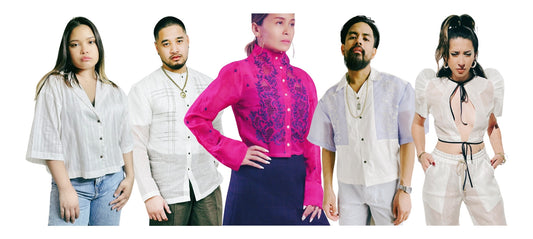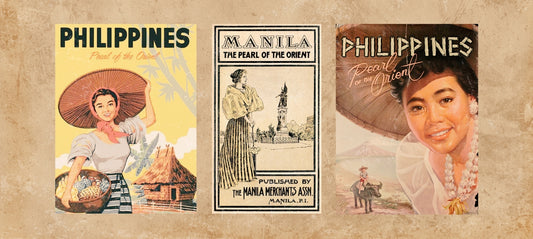Art Deco is a style of visual arts, architecture, and design that first appeared in France just before World War I. Art Deco also influenced the design of furniture, jewelry, fashion, cars, and everyday objects such as radios and vacuum cleaners. Most popular from the 1920s to the 1930s, in the Philippines, its popularity extended to the early 1960s, and used simple, stylized forms, linear motifs, zig-zags, lightning bolts, and geometrical patterns, and often set in vibrant colours —it was meant to represent the era’s machine age, and an increasingly liberal outlook in life. Filipino interpretations of the Art Deco movement is really central to VINTA's visual influence, including our logo.

The design for Filipino Deco II is an iconographic representation of the Abaca (Musa textilis) for its cultural value and the economics behind the textile, fibre industry, and its important and various uses in the Philippines, and the world over. The design shows the different parts and stages of the abaca plant, including its fruit, leaves, blossoms, and a cross section of its heart (which is the part where all the blossoms come from). It is a recognition and reverence to one of our likas na yaman (natural resource) that represents our national identity; and a reexamination on why it should also be acknowledged as our national plant.
Part of the Filipino Deco II design also includes the Philippine long-tailed macaque (Macaca fascicularis philippensis) that is found in all major Philippine islands. It is a subspecies of the crab-eating macaque, known in various Philippine languages as matsing or the more general term unggoy. They are often regarded as an agricultural pest as they tend to raid crops when farms are established near their home range. As a result, they are either hunted and killed. It is endemic to the Philippine forests and woodlands, but especially in the mangrove forests of western central Philippines in Palawan. During the day, they spend their time foraging for food on the ground and in trees. However, if there is a predator that becomes a major threat, the matsing can jump into nearby water and swim to safety. Turns out humans aren’t the only good swimmers in the primate world. The Philippine Long-tail macaque was abundant until the 1960s. Since that time, forest conversion processes and trapping have resulted in population declines. Though its current status is of near threatened, let’s work hard to raise awareness about this amazing primate and de-elevate its endangerment status back to least concern.
Did you know that Philippines is the largest producer of abaca fibres supplying about 87% of the world’s requirement for the production of making rope and cloth, for hats, slippers, brooms, fish nets, rugs, braided doilies, rice sacks, mosquito nets, cosmetics and skin care products, grocery bags, composites for automotive and construction and other industrial applications?
When Magellan arrived on the shores of our archipelago in 1521, the weaving industry was already well established. In fact, the Spanish government made cloth made from abaca legal tender for the payment of taxes. The monopoly farming of this plant started when the encomienda system was established by the Spaniards together with other cash crops. The blood and sweat of our farmers and ancestors literally watered this plant to multiply its population that has enriched our country and culture.
Abaca weaving is usually done in the homes on hand looms operated by the women. The products derived from abaca furnish a source of income for many Filipinos.
Not only is the abaca a vital crop for the Philippine economy, it is in fact vital to the world’s economy and environmental care as well. Abaca plays a vital role in the growing global advocacy for environmental protection and forest conservation. The strong worldwide interest and acceptability for “green” and “organic” products made manufacturing companies, especially in the US and Europe, turn to natural and bio-degradable raw materials like abaca. Being the strongest among all natural fibers and having superior qualities over other materials, abaca fibers are preferred over man-made fibres such as plastics and other synthetic materials by various industries around the world.
Abaca is also a suitable plant to be incorporated in reforestation farming system. The plant can assist in improving biodiversity conditions if intercropped with coconut palms and other tree species within former mono-culture plantations and rainforest areas. Planting abaca can also aid in minimizing erosion and sedimentation problems in coastal areas which are breeding grounds for sea fishes. The plant can effectively improve the water holding capacity of the soil therefore it can prevent floods and landslides as well. Further, the Abaca does not deplete soil as much as other plants and requires less land for its production. Abaca waste materials are used as organic fertilizer by farmers.
F i l i p i n o D e c o I

The first of Chesleigh Nofiel's (previously Alaga At Sining) Filipino Deco series, this one featuring the Philippines’ most fragrant ornamental flowers, set on a back drop of a slim cut and fully open button-down modern classic short-sleeved barong.
A fragrant garden has a wonderful ability to trigger memory—so often the flower fragrances that most appeals to us are the ones that we loved as children. This romantically designed Filipino Art Deco setting features sweetly scented flowers native in the Philippines, ornamental, tender and hardy.
Below, the Sanggumay flowers, a pendulous Dendrobium orchid species that are found in a wide range of habitats in the Philippines. The word Sanggumay was derived from Tagalog root words: "Sangsang" which means overpowering smell, and "Umay" meaning tire-some, surfeit, satiety.
One of the most aromatic staple flowers, the Ylang-ylang (Canaga odorata), appears prominently in the middle of the embroidery, a tropical tree that produces yellow flowers with a heavy, sweet, slightly fruity floral scent.
On top, surrounded by flowers of Dama de Noche (Cestrum nocturnum), a widely cultivated ornamental plant in the Philippines for its sweet-scented, white flowers, which bloom at night. It is supposedly the strongest smelling flower in the world as its aroma can be smelled 500 yards away.








